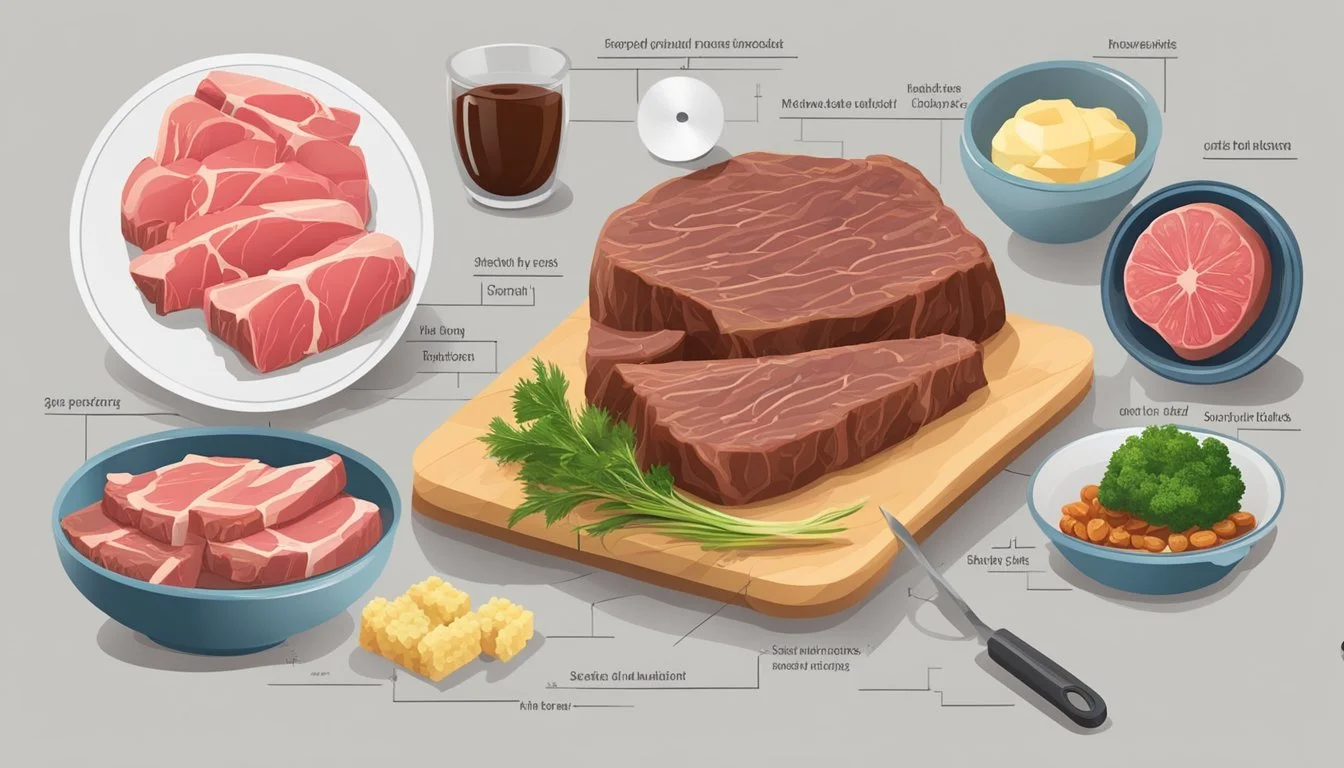How Much Beef Per Day is Too Much?
Understanding Dietary Limits
Determining the appropriate amount of beef in a daily diet has become a common health consideration. With a variety of nutrients like protein, iron, and B vitamins, beef can be an integral part of a balanced diet. However, it's essential to balance these benefits against the potential health risks associated with excessive consumption. Research suggests that moderation is key when it comes to eating red and processed meats, as high intake has been linked with health issues such as heart disease and certain cancers.
Health authorities often provide guidance on meat consumption. For instance, lean red meats (What wine goes well with red meat?) can fit within dietary guidelines when consumed in small to moderate amounts. It's generally recommended that individuals limit their red meat intake, with a focus on leaner cuts to minimize the intake of saturated fats which are associated with a higher risk of cardiovascular disease. Coupling beef with a variety of other protein sources, such as fish, poultry, beans, and legumes, can contribute to a diverse and healthful diet.
While there is no one-size-fits-all answer to the ideal amount of beef one should consume daily, it is widely advised that moderation and variety are important dietary strategies. Experts recommend diversifying protein sources instead of relying solely on red meat, and when beef is consumed, to choose less processed forms and opt for cooking methods that do not add extra fat or salt. This approach aligns with preventive health measures while allowing the enjoyment of beef as part of a balanced diet.
Understanding Red Meat and Health Risks
Red meat consumption is associated with various health risks, especially when intake exceeds moderate levels. Research suggests connections to several chronic conditions, notably cancer and heart disease. This section examines the specifics of these connections.
Connection Between Red Meat and Cancer
The World Health Organization's International Agency for Research on Cancer classifies processed meat as a Group 1 carcinogen, indicating that there's sufficient evidence linking it to cancer, particularly colon cancer. Unprocessed red meat falls under Group 2A, which suggests it is probably carcinogenic to humans. Studies point out that certain compounds formed during the cooking of red meat at high temperatures are potential contributors to these cancer risks.
Heart Disease and Processed Beef Products
Processed beef products, which often contain high levels of sodium and preservatives, are linked to an increased risk of cardiovascular disease. This is due to the potential for these additions to exacerbate high blood pressure and promote atherosclerosis, which can lead to heart attacks and strokes. The connection between red meat and heart disease is also influenced by the type and amount of meat consumed.
Impact of Saturated Fat and Cholesterol in Beef on Health
Beef contains saturated fat and cholesterol, both of which have been associated with higher levels of low-density lipoprotein (LDL) cholesterol in the bloodstream. Elevated LDL cholesterol is a well-established risk factor for developing cardiovascular disease. However, grass-fed beef typically has a more favorable composition of fats compared to grain-fed beef.
Nutritional Content of Beef
Beef is a nutrient-dense food choice that offers a rich source of high-quality protein as well as essential vitamins and minerals vital for overall health. It contributes significantly to muscle building, and provides key nutrients such as iron, zinc, and vitamin B12.
Protein and Muscle Building
Beef is an excellent source of high-quality protein, which is essential for muscle building and repair. A typical 3.5-ounce serving of cooked ground beef with 10% fat offers about 22 grams of protein. Protein from beef contains all the essential amino acids needed for the body to build and maintain muscle mass.
Iron, Zinc, and Vitamin B12 Content
Beef is also enriched with important minerals and vitamins:
Iron: Vital for the formation of hemoglobin in the blood, a 3.5-ounce serving of beef contains about 2.2 mg of iron.
Zinc: Necessary for a healthy immune system and metabolic function. The same serving of beef offers about 5.3 mg of zinc.
Vitamin B12: An essential vitamin for brain health and creating DNA. Beef is one of the best sources of vitamin B12, with a 3.5-ounce serving providing 2.1 mcg.
These nutrients play a crucial role in maintaining various physiological functions and contribute to the overall nutritional value of beef.
Dietary Recommendations and Limits
When considering the consumption of beef, it is vital to adhere to established dietary guidelines which recommend specific limits on portion sizes and frequency to maintain health.
USDA and World Health Organization Guidelines
The USDA (United States Department of Agriculture) suggests that adults consume no more than a combined total of 26 ounces of meat, poultry, and eggs per week. Within these parameters, the portion of red meat should be balanced and limited. The World Health Organization has classified red and processed meats as substances with potential cancer-causing effects, reinforcing the importance of moderation.
USDA Guideline: No more than 26 ounces of meat, poultry, and eggs per week.
WHO Recommendation: Limit intake of red and processed meats.
Portion Sizes and Frequency of Consumption
Understanding portion sizes is crucial. A single serving of cooked meat is approximately 3 ounces, likened to the size of a deck of cards. For lean red meat specifically, dietary guidelines encourage:
Maximum of 455 grams cooked (600-700 grams raw) per week.
Alternatively, a small portion (approximately 65 grams cooked) daily, or a larger portion (about 130 grams cooked) every other day to meet nutritional needs for iron and zinc without excess.
Frequency Cooked Portion Size Raw Portion Equivalent Daily 65g 100g Every Other Day 130g 200g
Consumers should be conscious of both the frequency of their beef intake and the portion sizes to align with a balanced and health-conscious diet.
Healthier Beef Choices
Selecting healthier options for beef consumption is pivotal for those looking to maintain a balanced diet. This includes choosing lean cuts and employing cooking methods that preserve nutritional value while minimizing unnecessary fats.
Selecting Leaner Cuts of Beef
Lean cuts of beef contain less fat, which can be beneficial for heart health and weight management. According to the USDA standards, a lean cut is one that contains less than 10 grams of total fat, 4.5 grams of saturated fat, and 95 milligrams of cholesterol per 3.5-ounce serving. Extra-lean cuts go further, with less than 5 grams of total fat and 2 grams of saturated fat per serving. Noteworthy lean cuts include:
Eye of round roast and steak: High in protein and low in fat.
Round tip roast and steak: Lean and economical, ideal for recipes calling for lean beef.
Top round roast and steak: Often used for deli meats, it cooks well with low-fat methods.
Bottom round roast and steak: Typically used for pot roast, it can be made leaner by trimming fat before cooking.
Top sirloin steak: A versatile cut that's both lean and flavorful.
Top loin steak: Provides a balance of tenderness and leanness.
By selecting these leaner cuts, individuals can enjoy beef as part of a health-conscious diet plan.
Preferred Cooking Methods for Health
The method by which beef is cooked can have a substantial impact on its healthfulness. To ensure beef retains its lean quality, certain cooking methods are preferable:
Grilling: Allows fat to drip away from the beef, reducing calorie and fat intake.
Roasting: Cooking beef in an oven at a lower temperature helps preserve moisture without adding extra fat.
Baking: Similar to roasting, baking beef in an oven can be done without oils, keeping fat content in check.
Broiling: High-intensity, direct heat helps to cook beef thoroughly while allowing fat to drip away.
These cooking techniques aid in preparing healthier beef dishes by maximizing flavor while minimizing added fats. It is recommended to avoid frying or cooking beef with excessive amounts of added fats, such as butter or oils, which can counteract the benefits of choosing leaner cuts.
Alternative Protein Sources
Diversifying protein intake can reduce reliance on beef and contribute to a balanced diet. Here, we explore plant-based proteins and their health advantages, as well as ways to include poultry, fish, and seafood as alternative protein sources.
Plant-Based Proteins and Health Benefits
Plant-based proteins such as beans, nuts, legumes, and lentils offer a rich source of protein and come with a myriad of health benefits. Beans, for instance, are not only high in protein but also provide dietary fiber, helping to maintain digestive health. A single cup of cooked lentils contains about 18 grams of protein, showcasing their nutrient density.
Nuts, including almonds and walnuts, deliver protein alongside healthy fats and fiber. Their regular consumption has been associated with heart health and reduced risk of chronic diseases. Additionally, legumes like chickpeas and black beans are versatile proteins that can be used in a variety of dishes, from salads to main courses, contributing to a feeling of fullness and aiding in weight management.
Health Benefits:
Improved heart health
Better weight management
Enhanced digestive health
Incorporating Poultry, Fish, and Seafood
When considering animal-based proteins apart from beef, poultry, fish, and seafood stand out as lean options. Chicken, a popular choice, is low in fat, high in protein, and serves as a good source of essential vitamins and minerals such as B vitamins, which are important for metabolism and energy production.
Fish and seafood are celebrated for their omega-3 fatty acid content, particularly fatty fish like salmon and mackerel, which support heart and brain health. A typical 4-ounce serving of salmon provides about 26 grams of protein, besides being a source of vitamin D and selenium. These protein alternatives not only yield substantial health benefits but also contribute to dietary variety.
Protein Sources:
Chicken: Lean, high in protein, contains B vitamins
Fish: Rich in omega-3 fatty acids, high in protein, contains vitamin D
Seafood: Includes shrimp and edamame, linked with heart and brain health benefits
Adjusting Dietary Habits
In striving for a balanced diet, individuals should consider their consumption of beef relative to other food groups. Moderation in meat intake and the inclusion of a variety of produce can optimize health benefits and support weight management.
Balancing Meat Intake with Fruits and Vegetables
A balanced plate reflects diversity in food choices, acknowledging the importance of both animal-based and plant-based nutrients. For meat enthusiasts, this means adjusting beef intake to leave ample room for fruits and vegetables. The USDA's MyPlate guide suggests filling half of one's plate with fruits and vegetables. These food groups provide essential vitamins, minerals, and fibers, which can alleviate the potential risks associated with excessive red meat consumption.
To illustrate:
Half Plate: Fruits and Vegetables
Examples: Broccoli, spinach, carrots, apples, and berries.
One Quarter Plate: Grains, Preferably Whole Grains
Examples: Brown rice, quinoa, whole wheat pasta, and oatmeal.
One Quarter Plate: Protein, Emphasizing Variety
Moderation in Beef Intake: Opt for lean cuts and consider plant-based proteins as complements.
Creating a Balanced Plate for Weight Loss and Maintenance
When it comes to weight loss and maintenance, portion control and nutrient density are key. A balanced plate should contain:
High Fiber and Low Calorie Vegetables
This increases satiety without excessive calorie intake.
Examples: Lettuce, kale, and other leafy greens.
Lean Protein To Support Metabolic Functions
Beef can be included, but in smaller portions, rotated with other proteins.
Protein Portion: Approximately 3-4 ounces, the size of a deck of cards.
Whole Grains For Sustained Energy
They provide complex carbohydrates that help manage cravings and support weight loss.
Portion Guide: About a quarter of the plate.
This section prioritizes balance and moderation in dietary habits, promoting a holistic approach to eating that can lead to sustainable weight loss and overall well-being.
Meat Consumption and Global Impact
Excessive meat consumption, particularly beef, not only affects human health but also has significant environmental implications. This section explores these impacts and observes changing patterns in how meat is consumed globally.
Environmental Considerations of Meat Production
Beef production is notably resource-intensive and a major contributor to greenhouse gas (GHG) emissions. Specifically, ruminant livestock such as cattle, which are raised for beef, emit methane through enteric fermentation. In terms of GHG emissions, the production of red meats like beef is markedly higher than that of white meats. (What wine goes well with white meat?)To give some perspective:
Red meat production emits over 20 times more GHGs per gram of protein than plant foods
Beef cattle account for 65% of the livestock sector's GHG emissions
Deforestation is another major concern, where land is cleared for pasture or to grow feed crops, threatening biodiversity and increasing carbon emissions.
Shifting Trends in Meat Consumption
Global meat consumption patterns are evolving. In some higher-income countries, meat consumption, specifically daily beef intake, has decreased. A study noted a 17% reduction in average daily meat consumption per person over recent years. Meanwhile, in developing countries, the demand for meat continues to rise due to growing populations and increased affluence.
Despite these shifts, the overall demand for meat is projected to grow, posing ongoing challenges for sustainability objectives. Campaigns and policy efforts strive to encourage balanced diets with reduced meat intake, emphasizing the sustainability of food production and its broader impacts on the planet.
Expert Insights
In determining how much beef per day is too much, the insights from nutritionists and dietitians are critical. They provide guidelines that balance the needs of the body with the risks associated with excessive beef consumption.
Advice from Nutritionists and Dietitians
Nutritionists and registered dietitians often emphasize the importance of moderation when it comes to beef intake. The following are specific points they advise:
Moderation: They typically recommend that adults should consume no more than 5.5 ounces of protein foods, like beef, per day as part of a balanced diet, depending on the individual's caloric needs.
Lean Cuts: When including beef in the diet, selecting lean cuts helps limit saturated fat intake, which is advisable for cardiovascular health.
Nutritional Balance: A diverse diet that balances protein with ample fruits, vegetables, and whole grains is stressed by experts to prevent diseases and ensure overall health.
Identifying Personal Health Goals and Dietary Needs
Individual health goals and dietary needs dictate personalized beef consumption recommendations:
Health Status and Age: Elderly individuals or those with specific health conditions may need to adjust their beef intake accordingly.
Activity Level: Active adults may require more protein and can often consume higher amounts of beef compared to less active individuals.
By considering one's unique physiology and health objectives, nutritionists and dietitians craft tailored dietary plans that align with medical guidance for maintaining health and preventing diseases.
Conclusion
Consumers have been reducing their beef intake over recent years, contributing to progress in dietary habits. It is essential to strike a balance when consuming beef, as part of a heart-healthy diet. Data suggests that on average, Americans consume roughly 1.26 pounds of beef per week. This trend is in response to concerns about the risks associated with high red meat consumption, particularly related to heart health.
Cholesterol levels, a key indicator for cardiovascular health, can be influenced by beef intake due to its saturated fat content. Reducing the amount of beef, especially processed forms, can help manage cholesterol.
One should be aware of the following dietary guidelines:
Men are advised to consume around 4 to 6 ounces of lean meat per day.
Women should target approximately 3 to 5 ounces of lean meat daily.
Incorporating these portions into a balanced diet can help maintain optimal health while enjoying the nutritional benefits that beef offers. Individuals concerned about heart health, cholesterol levels, or overall meat consumption, should consult with healthcare providers to personalize dietary intake that corresponds with their health status and goals.









